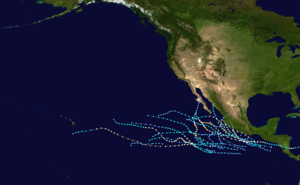| 1971 Pacific hurricane season | |
|---|---|
 Season summary map | |
| Seasonal boundaries | |
| First system formed | May 21, 1971 |
| Last system dissipated | November 29, 1971 |
| Strongest storm | |
| By maximum sustained winds | Denise |
| • Maximum winds | 140 mph (220 km/h) (1-minute sustained) |
| • Lowest pressure | 951 mbar (hPa; 28.08 inHg) |
| By central pressure | Olivia |
| • Maximum winds | 115 mph (185 km/h) (1-minute sustained) |
| • Lowest pressure | 948 mbar (hPa; 27.99 inHg) |
| Seasonal statistics | |
| Total depressions | 22 |
| Total storms | 18 |
| Hurricanes | 12 |
| Major hurricanes (Cat. 3+) | 6 |
| Total fatalities | 31 total |
| Total damage | $40 million (1971 USD) |
| Related articles | |
The 1971 Pacific hurricane season began on May 15, 1971 in the eastern Pacific (east of 140°W), and on June 1, 1971 in the Central Pacific (from 140°W to the International Date Line); both ended on November 30, 1971. These dates, adopted by convention, historically describe the period in each year when most tropical cyclogenesis occurs in these regions of the Pacific. It was the first year that continuous Weather satellite coverage existed over the entire Central Pacific. As such, this season is often viewed as the start year for modern reliable tropical cyclone data in the Pacific Ocean.[1]
It was an above average pacific hurricane season with 22 tropical cyclones forming, of which 18 became named storms. During the season, 12 storms became hurricanes, of which 6 became major hurricanes by reaching Category 3 or higher on the Saffir-Simpson Hurricane Scale. At the time, this was a single-season record number of storms. This season also had a record 6 systems make landfall: Agatha, Bridget, Katrina, Lily, Olivia and Priscilla.
- ^ "Tropical Cyclone Climatology". College Park, Maryland: NOAA Climate Prediction Center. Retrieved August 15, 2023.